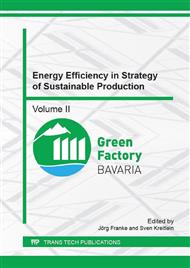[1]
Bundesministerium für Wirtschaft und Energie, Gesetz für den Vorrang Erneuerbarer Energien (Erneuerbare-Energien-Gesetz - EEG): EEG, (2008).
DOI: 10.1007/978-3-658-07554-5_2
Google Scholar
[2]
Bundesministerium für Wirtschaft und Energie, Mehr aus Energie machen - Nationaler Aktionsplan für Energieeffizienz, Berlin, (2014).
Google Scholar
[3]
O. Ekren, B.Y. Ekren, Size optimization of a PV/wind hybrid energy conversion system with battery storage using simulated annealing, Applied Energy 87 (2010) 592–598.
DOI: 10.1016/j.apenergy.2009.05.022
Google Scholar
[4]
O. Erdinc, M. Uzunoglu, Optimum design of hybrid renewable energy systems: Overview of different approaches, Renewable and Sustainable Energy Reviews 16 (2012) 1412–1425.
DOI: 10.1016/j.rser.2011.11.011
Google Scholar
[5]
R.S. Garcia, D. Weisser, A wind–diesel system with hydrogen storage: Joint optimisation of design and dispatch, Renewable Energy 31 (2006) 2296–2320.
DOI: 10.1016/j.renene.2005.11.003
Google Scholar
[6]
E. Koutroulis, D. Kolokotsa, A. Potirakis, K. Kalaitzakis, Methodology for optimal sizing of stand-alone photovoltaic/wind-generator systems using genetic algorithms, Solar Energy 80 (2006) 1072–1088.
DOI: 10.1016/j.solener.2005.11.002
Google Scholar
[7]
B. Muster-Slawitsch, W. Weiss, H. Schnitzer, C. Brunner, The green brewery concept - Energy efficiency and the use of renewable energy sources in breweries, Applied Thermal Engineering (2011).
DOI: 10.1016/j.applthermaleng.2011.03.033
Google Scholar
[8]
C. Eicke, M. Krause, Das E-Modell der Energieautarkie, Hochschule Hannover, (2014).
Google Scholar
[9]
R. McKenna, T. Jäger, W. Fichtner, Energieautarkie – ausgewählte Ansätze und Praxiserfahrungen im deutschsprachigen Raum, uwf 22 (2014) 241–247.
DOI: 10.1007/s00550-014-0339-y
Google Scholar
[10]
R. McKenna, E. Merkel, W. Fichtner, Energy autonomy in residential buildings: a techno-economic modelbased analysis of the scale effects. Working paper series in production and energy, Karlsruhe, (2016).
DOI: 10.1016/j.apenergy.2016.03.062
Google Scholar
[11]
T.M. Kneiske, C. Hoffmann, Eigenstromnutzung, in: R. Neugebauer (Ed. ), Handbuch Ressourcenorientierte Produktion, Carl Hanser Verlag, München, Wien, 2013, p.330–340.
Google Scholar
[12]
M. Schreiber, Bewertungskriterien einer optimierten Energieversorgung regionaler Verbünde mit hohen Anteilen erneuerbarer Erzeugung, Zeitschrift für Energiewirtschaft (2012) 257–265.
DOI: 10.1007/s12398-012-0090-4
Google Scholar
[13]
Information on http: /www. dwd. de/DE/klimaumwelt/cdc/cdc_node. html.
Google Scholar


